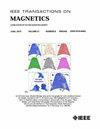基于h基有限元公式的磁通连杆计算方法
IF 1.9
3区 工程技术
Q3 ENGINEERING, ELECTRICAL & ELECTRONIC
引用次数: 0
摘要
这项工作提出了四种方法来获得通量连杆沿${\boldsymbol {H}}$为基础的公式在相同的优雅和有效的方式沿磁矢量势公式。在后处理步骤中,发现磁矢量势:1)作为惩罚${\boldsymbol {H}}$ -公式的副产品;2)通过求解附加场问题;3) Biot-Savart (BS)积分;4)用庞卡罗积分。磁标量势公式结合BS或poincar本文章由计算机程序翻译,如有差异,请以英文原文为准。
Methods to Compute Magnetic Flux Linkages Along H-Based Finite Element Formulations
This work presents four methods to obtain flux linkages along an ${\boldsymbol {H}}$ -based formulation in the same elegant and efficient way as along magnetic vector potential formulations. In a post-processing step, the magnetic vector potential is found: 1) as a by-product of a penalized ${\boldsymbol {H}}$ -formulation; 2) by solving an additional field problem; 3) by the Biot–Savart (BS) integral; and 4) by the Poincaré integral. The magnetic scalar potential formulation combined with the BS or the Poincaré integral allows to solve the magnetic field and post-process the magnetic fluxes of an industry-relevant example with a five times better computational efficiency than the standard magnetic vector potential approach.
求助全文
通过发布文献求助,成功后即可免费获取论文全文。
去求助
来源期刊

IEEE Transactions on Magnetics
工程技术-工程:电子与电气
CiteScore
4.00
自引率
14.30%
发文量
565
审稿时长
4.1 months
期刊介绍:
Science and technology related to the basic physics and engineering of magnetism, magnetic materials, applied magnetics, magnetic devices, and magnetic data storage. The IEEE Transactions on Magnetics publishes scholarly articles of archival value as well as tutorial expositions and critical reviews of classical subjects and topics of current interest.
 求助内容:
求助内容: 应助结果提醒方式:
应助结果提醒方式:


